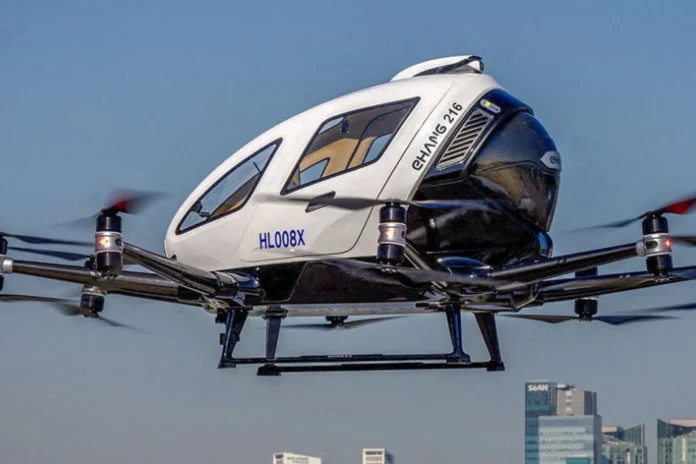Moving into the future of urban transportation, China’s M1 flying taxi recently completed a successful test flight, marking a significant milestone in the development of electric vertical take-off and landing (eVTOL) aircraft. This futuristic “flying taxi” has the potential to revolutionize the way we travel around, and its recent achievement guarantees a closer look into the future.
Technical Specs of M1 Flying Taxi
Let’s start with the nuts and bolts. The M1, designed and developed by Shanghai Aviation Technology, is a two-ton aircraft with impressive capabilities. Imagine a sleek, metallic bird with a 10-meter length, 3-meter height, and 15-meter wingspan. Inside, it comfortably accommodates up to five passengers, ready to zip through the urban sky at 200 kilometers per hour cruising speed. With a range of 250 kilometers, the M1 flying taxi can take you across packed cityscapes or between neighboring towns in a fraction of the time it takes by car.
Electric Revolution
One of the most exciting aspects of the M1 is its electric driving force. The days of noisy roads are gone with pollution-spewing helicopters. The M1 glides silently on clean electric power, contributing to a more sustainable future for our cities. This not only benefits the environment but also creates a quieter, more peaceful travel experience for passengers.
Vertical Advantage
Another key feature of the M1 is its vertical take-off and landing (VTOL) capability. No more straight runways or long taxiing delays! Inspired by Hexa drones, The M1 can lift off and land like a giant hummingbird, requiring only a small, designated landing zone. This opens up a world of possibilities for urban air travel, allowing for convenient point-to-point transportation without the uneasiness of traditional airports.
Simple Assembly
The M1 flying taxi is not only cutting-edge technology but has practical design considerations. Its lightweight carbon fiber construction makes it remarkably easy to assemble, requiring only a small team of 2-3 people. This reduces maintenance costs and makes it easier to deploy the M1 in various locations, further increasing its accessibility.
Global Implications
China’s successful test flight of the M1 flying taxi is not just a national achievement; it has sent ripples through the global transportation industry. The M1’s capabilities and its place as a forerunner in the eVTOL race demonstrate China’s commitment to innovation and its potential to become a leader in this emerging field. This success is bound to inspire further development and competition around the world, ultimately accelerating the progress of urban air travel for everyone.
Challenges on the Road Ahead
While the success of the M1 flying taxi’s test flight is a cause for celebration for many, there are still challenges to overcome before eVTOL aircraft become a regular part of our lives. Safety regulations, infrastructure development, and public acceptance are just some of the difficulties that must be addressed. However, the successful test flight of the M1 indicates that the technology is maturing and moving closer to reality.
Glimpse of the Future
Imagine a world where air taxis are as commonplace as Uber cars. The M1 is a solid step towards that future, offering a glimpse into a world where urban transportation is faster, cleaner, and more efficient. With continued development and collaboration, the skies above our cities could soon buzz with these silent, electric birds, carrying us towards a new era of mobility, as shown in fiction.
The successful test flight of the M1 flying taxi is more than just a technological accomplishment; it represents a leap of imagination and a commitment to shaping a better future. As we watch this technology evolve, we can’t help but wonder what more exciting possibilities lie ahead for the skies above us.



